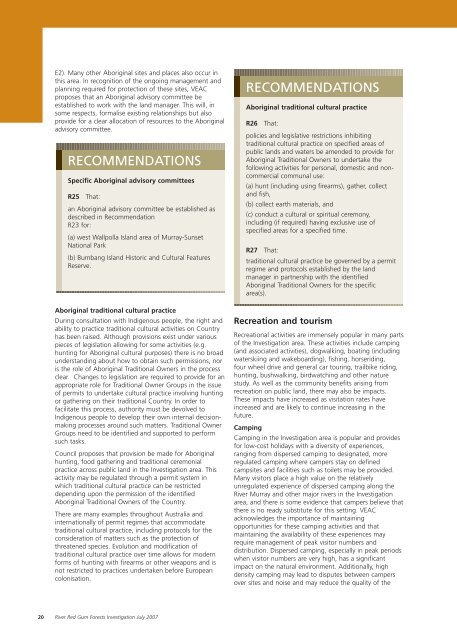Draft Proposals Paper - Full - Victorian Environmental Assessment ...
Draft Proposals Paper - Full - Victorian Environmental Assessment ...
Draft Proposals Paper - Full - Victorian Environmental Assessment ...
Create successful ePaper yourself
Turn your PDF publications into a flip-book with our unique Google optimized e-Paper software.
E2). Many other Aboriginal sites and places also occur in<br />
this area. In recognition of the ongoing management and<br />
planning required for protection of these sites, VEAC<br />
proposes that an Aboriginal advisory committee be<br />
established to work with the land manager. This will, in<br />
some respects, formalise existing relationships but also<br />
provide for a clear allocation of resources to the Aboriginal<br />
advisory committee.<br />
RECOMMENDATIONS<br />
Specific Aboriginal advisory committees<br />
R25 That:<br />
an Aboriginal advisory committee be established as<br />
described in Recommendation<br />
R23 for:<br />
(a) west Wallpolla Island area of Murray-Sunset<br />
National Park<br />
(b) Bumbang Island Historic and Cultural Features<br />
Reserve.<br />
Aboriginal traditional cultural practice<br />
During consultation with Indigenous people, the right and<br />
ability to practice traditional cultural activities on Country<br />
has been raised. Although provisions exist under various<br />
pieces of legislation allowing for some activities (e.g.<br />
hunting for Aboriginal cultural purposes) there is no broad<br />
understanding about how to obtain such permissions, nor<br />
is the role of Aboriginal Traditional Owners in the process<br />
clear. Changes to legislation are required to provide for an<br />
appropriate role for Traditional Owner Groups in the issue<br />
of permits to undertake cultural practice involving hunting<br />
or gathering on their traditional Country. In order to<br />
facilitate this process, authority must be devolved to<br />
Indigenous people to develop their own internal decisionmaking<br />
processes around such matters. Traditional Owner<br />
Groups need to be identified and supported to perform<br />
such tasks.<br />
Council proposes that provision be made for Aboriginal<br />
hunting, food gathering and traditional ceremonial<br />
practice across public land in the Investigation area. This<br />
activity may be regulated through a permit system in<br />
which traditional cultural practice can be restricted<br />
depending upon the permission of the identified<br />
Aboriginal Traditional Owners of the Country.<br />
There are many examples throughout Australia and<br />
internationally of permit regimes that accommodate<br />
traditional cultural practice, including protocols for the<br />
consideration of matters such as the protection of<br />
threatened species. Evolution and modification of<br />
traditional cultural practice over time allows for modern<br />
forms of hunting with firearms or other weapons and is<br />
not restricted to practices undertaken before European<br />
colonisation.<br />
RECOMMENDATIONS<br />
Aboriginal traditional cultural practice<br />
R26 That:<br />
policies and legislative restrictions inhibiting<br />
traditional cultural practice on specified areas of<br />
public lands and waters be amended to provide for<br />
Aboriginal Traditional Owners to undertake the<br />
following activities for personal, domestic and noncommercial<br />
communal use:<br />
(a) hunt (including using firearms), gather, collect<br />
and fish,<br />
(b) collect earth materials, and<br />
(c) conduct a cultural or spiritual ceremony,<br />
including (if required) having exclusive use of<br />
specified areas for a specified time.<br />
R27 That:<br />
traditional cultural practice be governed by a permit<br />
regime and protocols established by the land<br />
manager in partnership with the identified<br />
Aboriginal Traditional Owners for the specific<br />
area(s).<br />
Recreation and tourism<br />
Recreational activities are immensely popular in many parts<br />
of the Investigation area. These activities include camping<br />
(and associated activities), dogwalking, boating (including<br />
waterskiing and wakeboarding), fishing, horseriding,<br />
four wheel drive and general car touring, trailbike riding,<br />
hunting, bushwalking, birdwatching and other nature<br />
study. As well as the community benefits arising from<br />
recreation on public land, there may also be impacts.<br />
These impacts have increased as visitation rates have<br />
increased and are likely to continue increasing in the<br />
future.<br />
Camping<br />
Camping in the Investigation area is popular and provides<br />
for low-cost holidays with a diversity of experiences,<br />
ranging from dispersed camping to designated, more<br />
regulated camping where campers stay on defined<br />
campsites and facilities such as toilets may be provided.<br />
Many visitors place a high value on the relatively<br />
unregulated experience of dispersed camping along the<br />
River Murray and other major rivers in the Investigation<br />
area, and there is some evidence that campers believe that<br />
there is no ready substitute for this setting. VEAC<br />
acknowledges the importance of maintaining<br />
opportunities for these camping activities and that<br />
maintaining the availability of these experiences may<br />
require management of peak visitor numbers and<br />
distribution. Dispersed camping, especially in peak periods<br />
when visitor numbers are very high, has a significant<br />
impact on the natural environment. Additionally, high<br />
density camping may lead to disputes between campers<br />
over sites and noise and may reduce the quality of the<br />
20 River Red Gum Forests Investigation July 2007
















